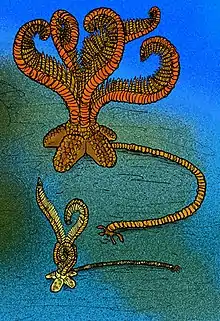| Calceolispongia Temporal range: Permian | |
|---|---|
 | |
| Calceolispongia hindei | |
| Scientific classification | |
| Kingdom: | |
| Phylum: | |
| Class: | |
| Subclass: | |
| Order: | |
| Family: | †Calceolispongiidae |
| Genus: | †Calceolispongia |
| Species | |
| |
Calceolispongia (literally "shoe sponge") is a diverse genus of cladid crinoids that lived along the shores of eastern Pangaea that correspond to Timor and Western Australia, today.[1]
When the first fossils were discovered, they were mistakenly thought to be sponges, hence the generic name.[2] Later, similarly shaped fossils were found, and (correctly) identified as those of a crinoid, and named "Dinocrinus." ("Terrible Lily") It was soon realized that Dinocrinus and Calceolispongia were the same, and Dinocrinus is now regarded as a junior synonym.
References
- ↑ Teichert, Curt (1954). "A New Permian Crinoid from Western Australia". Journal of Paleontology. 28 (1): 70–75. ISSN 0022-3360. JSTOR 1300210.
- ↑ Teichert, Curt (1949). Permian Crinoid Calceolispongia. Geological Society of America. ISBN 978-0-8137-1034-1.
This article is issued from Wikipedia. The text is licensed under Creative Commons - Attribution - Sharealike. Additional terms may apply for the media files.